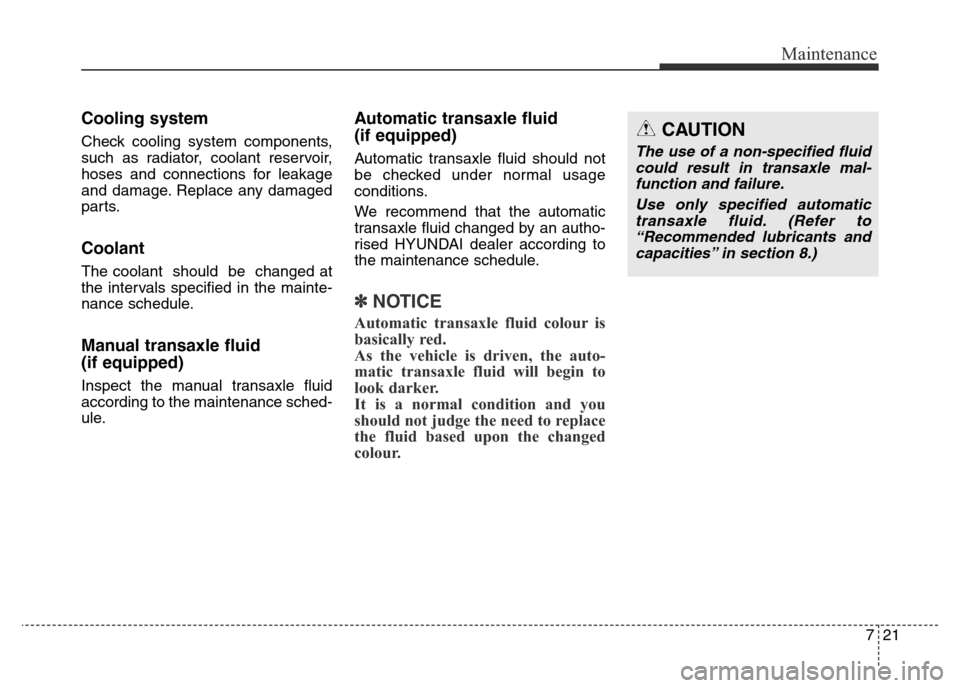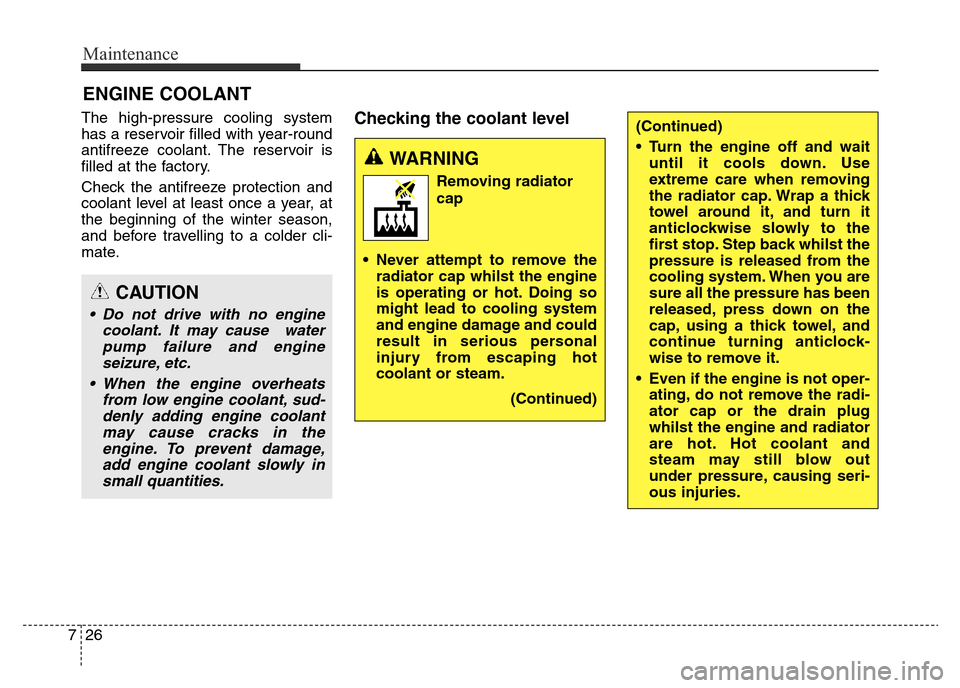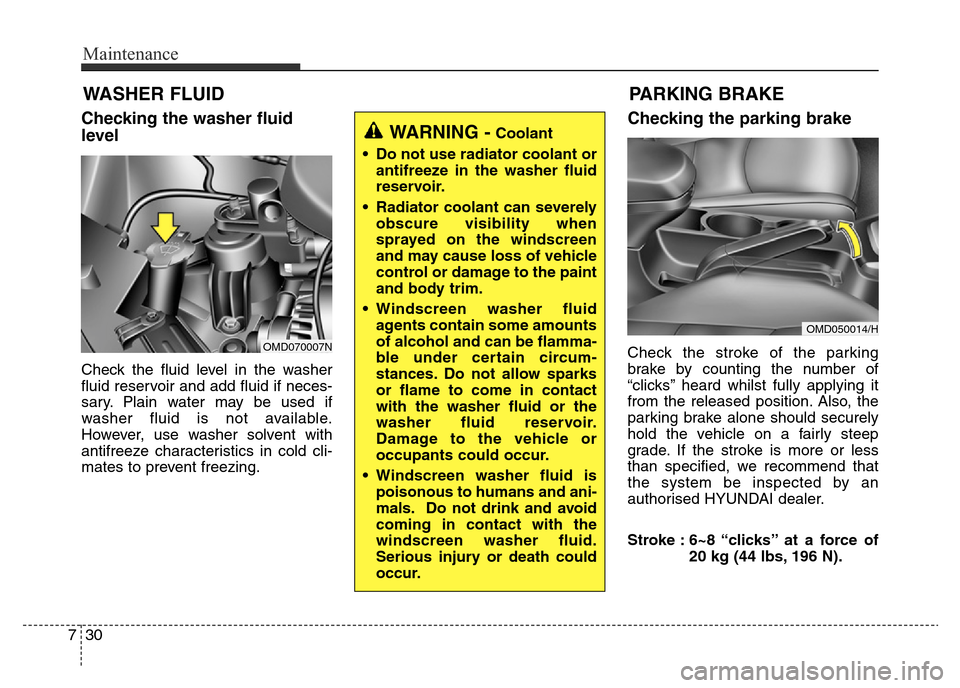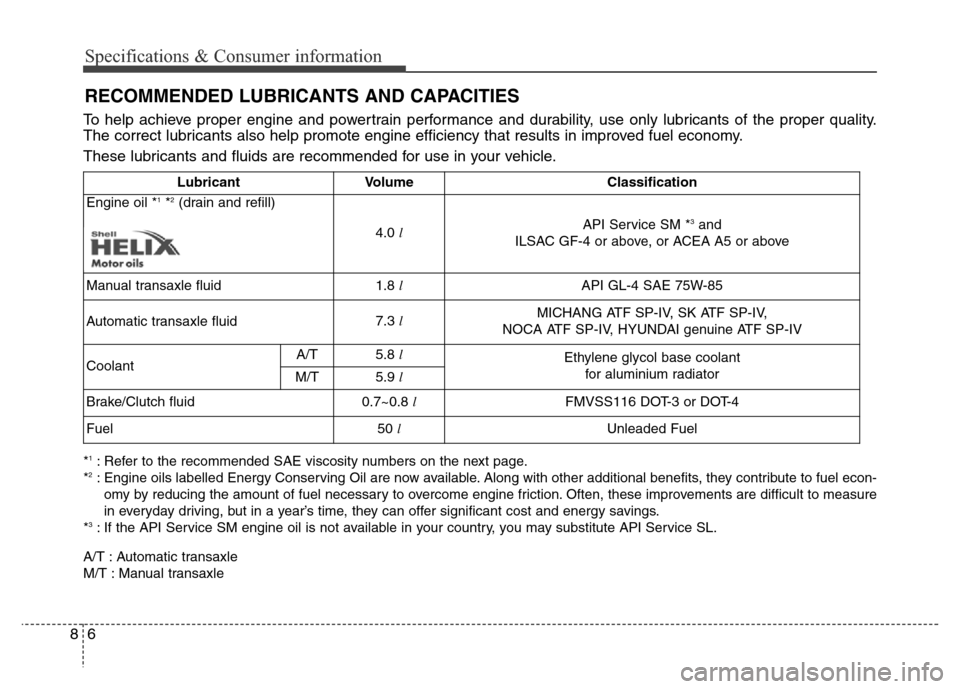Page 416 of 498

721
Maintenance
Cooling system
Check cooling system components,
such as radiator, coolant reservoir,
hoses and connections for leakage
and damage. Replace any damaged
parts.
Coolant
The coolant should be changed at
the intervals specified in the mainte-
nance schedule.
Manual transaxle fluid
(if equipped)
Inspect the manual transaxle fluid
according to the maintenance sched-
ule.
Automatic transaxle fluid
(if equipped)
Automatic transaxle fluid should not
be checked under normal usage
conditions.
We recommend that the automatic
transaxle fluid changed by an autho-
rised HYUNDAI dealer according to
the maintenance schedule.
✽NOTICE
Automatic transaxle fluid colour is
basically red.
As the vehicle is driven, the auto-
matic transaxle fluid will begin to
look darker.
It is a normal condition and you
should not judge the need to replace
the fluid based upon the changed
colour.
CAUTION
The use of a non-specified fluid
could result in transaxle mal-
function and failure.
Use only specified automatic
transaxle fluid. (Refer to
“Recommended lubricants and
capacities” in section 8.)
Page 418 of 498
723
Maintenance
ENGINE OIL
Checking the engine oil level
1. Ensure the vehicle is on level
ground.
2. Start the engine and allow it to
reach normal operating tempera-
ture.
3. Turn the engine off and wait for a
few minutes (about 5 minutes) for
the oil to return to the oil pan.
4. Pull the dipstick out, wipe it clean,
and reinsert it fully.5. Pull the dipstick out again and
check the level. The level should
be between F (Full) and L (Low).
WARNING - Radiator
hose
Be very careful not to touch the
radiator hose when checking or
adding the engine oil as it may
be hot enough to burn you.CAUTION
• Do not spill engine oil, when
adding or changing engine oil.
If you spill engine oil in the
engine compartment, wipe it
off immediately.
• When you wipe the oil level
gauge, you should wipe it with
a clean cloth. When mixed
with debris, it can cause
engine damage.
OMD071002L
Page 421 of 498

Maintenance
26 7
ENGINE COOLANT
The high-pressure cooling system
has a reservoir filled with year-round
antifreeze coolant. The reservoir is
filled at the factory.
Check the antifreeze protection and
coolant level at least once a year, at
the beginning of the winter season,
and before travelling to a colder cli-
mate.Checking the coolant level(Continued)
• Turn the engine off and wait
until it cools down. Use
extreme care when removing
the radiator cap. Wrap a thick
towel around it, and turn it
anticlockwise slowly to the
first stop. Step back whilst the
pressure is released from the
cooling system. When you are
sure all the pressure has been
released, press down on the
cap, using a thick towel, and
continue turning anticlock-
wise to remove it.
• Even if the engine is not oper-
ating, do not remove the radi-
ator cap or the drain plug
whilst the engine and radiator
are hot. Hot coolant and
steam may still blow out
under pressure, causing seri-
ous injuries.
WARNING
Removing radiator
cap
• Never attempt to remove the
radiator cap whilst the engine
is operating or hot. Doing so
might lead to cooling system
and engine damage and could
result in serious personal
injury from escaping hot
coolant or steam.
(Continued)
CAUTION
• Do not drive with no engine
coolant. It may cause water
pump failure and engine
seizure, etc.
• When the engine overheats
from low engine coolant, sud-
denly adding engine coolant
may cause cracks in the
engine. To prevent damage,
add engine coolant slowly in
small quantities.
Page 423 of 498
Maintenance
28 7
Changing the coolant
We recommend that the coolant be
replaced by an authorised HYUNDAI
dealer.
WARNING
Radiator cap
Do not remove the radiator cap
when the engine and radiator are
hot. Scalding hot coolant and
steam may blow out under pres-
sure causing serious injuries.
OMD071005L
CAUTION
Put a thick cloth or fabric
around the radiator cap before
refilling the coolant in order to
prevent the coolant from over-
flowing into engine parts such
as the alternator.
WARNING -Coolant
• Do not use radiator coolant or
antifreeze in the washer fluid
reservoir.
• Radiator coolant can severely
obscure visibility when
sprayed on the windscreen
and may cause loss of vehicle
control or damage to paint
and body trim.
Page 425 of 498

Maintenance
30 7
WASHER FLUID
Checking the washer fluid
level
Check the fluid level in the washer
fluid reservoir and add fluid if neces-
sary. Plain water may be used if
washer fluid is not available.
However, use washer solvent with
antifreeze characteristics in cold cli-
mates to prevent freezing.
Checking the parking brake
Check the stroke of the parking
brake by counting the number of
“clicks’’ heard whilst fully applying it
from the released position. Also, the
parking brake alone should securely
hold the vehicle on a fairly steep
grade. If the stroke is more or less
than specified, we recommend that
the system be inspected by an
authorised HYUNDAI dealer.
Stroke : 6~8 “clicks’’ at a force of
20 kg (44 lbs, 196 N).
PARKING BRAKE
WARNING -Coolant
• Do not use radiator coolant or
antifreeze in the washer fluid
reservoir.
• Radiator coolant can severely
obscure visibility when
sprayed on the windscreen
and may cause loss of vehicle
control or damage to the paint
and body trim.
• Windscreen washer fluid
agents contain some amounts
of alcohol and can be flamma-
ble under certain circum-
stances. Do not allow sparks
or flame to come in contact
with the washer fluid or the
washer fluid reservoir.
Damage to the vehicle or
occupants could occur.
• Windscreen washer fluid is
poisonous to humans and ani-
mals. Do not drink and avoid
coming in contact with the
windscreen washer fluid.
Serious injury or death could
occur.
OMD070007N
OMD050014/H
Page 495 of 498

Specifications & Consumer information
6 8
RECOMMENDED LUBRICANTS AND CAPACITIES
*1: Refer to the recommended SAE viscosity numbers on the next page.
*2: Engine oils labelled Energy Conserving Oil are now available. Along with other additional benefits, they contribute to fuel econ-
omy by reducing the amount of fuel necessary to overcome engine friction. Often, these improvements are difficult to measure
in everyday driving, but in a year’s time, they can offer significant cost and energy savings.
*
3: If the API Service SM engine oil is not available in your country, you may substitute API Service SL.
A/T : Automatic transaxle
M/T : Manual transaxle
To help achieve proper engine and powertrain performance and durability, use only lubricants of the proper quality.
The correct lubricants also help promote engine efficiency that results in improved fuel economy.
These lubricants and fluids are recommended for use in your vehicle.
Lubricant Volume Classification
Engine oil *1*2(drain and refill)
4.0 lAPI Service SM *3and
ILSAC GF-4 or above, or ACEA A5 or above
Manual transaxle fluid1.8 l
API GL-4 SAE 75W-85
Automatic transaxle fluid7.3 lMICHANG ATF SP-IV, SK ATF SP-IV,
NOCA ATF SP-IV, HYUNDAI genuine ATF SP-IV
CoolantA/T5.8 l
Ethylene glycol base coolant
for aluminium radiator
M/T5.9 l
Brake/Clutch fluid0.7~0.8 l
FMVSS116 DOT-3 or DOT-4
Fuel50 l
Unleaded Fuel